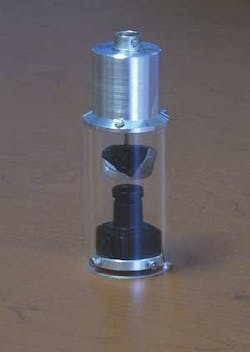By Winn Hardin
ORLANDO, Fla. — Unlike most other sensor types — including motion, trip wire, and radar — video closed-circuit television (CCTV) and infrared (IR) imaging systems can provide the powerful triumvirate of threat detection, identification, and target tracking using one camera and an image-processing unit.
At the recent defense industry Aerosense exhibit and conference in Orlando, Fla., companies such as Digital Infrared Imaging in Apopka, Fla., and FLIR Systems Inc. in Portland, Ore., showed the latest in gimbal directional imaging systems with long-range optics and fast pan/tilt capabilities.
These systems mechanically rotate across a field of view and — with the assistance of image processors — detect, identify, and track targets. However, a camera that can only see in one direction at any given time is potentially vulnerable.
null
In response, Genex Technologies Inc. in Kensington, Md., is offering several new systems that provide 360-degree surveillance capabilities in the visible, IR, or a combination of both. The new family of systems is called OmniEye, and including the OmniEye PTZ (pan, tilt, zoom) system, the OmniEye NightWatch, the OmniEye Cerberus, and the soon-to-be-released Small Tactical Ubiquitous Detection Sensor (STUDS).
Indoor surveillance
Known as a research-and-development house for security and military technology, Genex is working with several partners to move into product development for emerging defense and homeland security applications.
The OmniEye PTZ is for indoor applications where physical access control and personnel tracking and monitoring are crucial across short distances. "The system lets you track multiple targets in any direction as they move through an area. Each target detected can direct a pan-tilt-zoom (PTZ) camera to zoom in on the subject for high-resolution recognition and tracking," explains David Tunnell, Genex's vice president for government solutions.
The OmniEye PTZ is a small hemispherical mirror hung from a ceiling or similar structure. Designers place a visible charge-coupled device (CCD) camera or one of several IR sensors at the bottom of the glass bubble, and point the sensor up into the hyperbolic mirror. The camera detects people or objects in the mirror's fisheye view and then directs a second staring visible-light or IR camera to focus on subjects of high interest and potential threat.
Cerberus and NightWatch are the latest additions to the OmniEye 360-degree security camera family. Genex designers increased the resolution of both systems by incorporating several different imagers while providing real-time 30 Hz video monitoring over 360-degrees.
All eyes outward
NightWatch is designed for indoor or outdoor short-to-medium-range perimeter surveillance applications, such as protecting the Future Combat Vehicle. The system uses as many as eight uncooled long-wave IR sensors of virtually any type.
The architecture is modular, and enables integrators to configure virtually any sensor, although it is currently specified for the Raytheon 2000 AS sensor — an amorphous silicon-based microbolometer sensor with 160 by 120 pixels per sensor.
Genex's software package, OmniVision, is common to all the systems. The software mosaics the real-time video streams from each sensor into one panoramic view. Thus the Raytheon 2000 AS sensor configuration yields one image in resolutions as large as 1,280 by 120 pixels. Integrators can change the coverage area and number of sensors at the customer's request and depending on the width of the surveillance arc. For example, a system designed for 180 degrees of coverage would use four senors while a 270-degree coverage arc requires six sensors.
"OmniVision software provides us with a flexible architecture that allows us to be modular in our hardware and software, so that we can accommodate nearly any type of [imaging array] sensor," Tunnell says. "It also allows us to download new algorithms for our Smart Optical Sensor [SOS] image processing, which is at the heart of our system design."
null
Unlike NightWatch, which has a relatively small size that helps integrators relocate the system if necessary, Cerberus is designed as a permanent installation on surface ships, submarines, buoys, and navigational beacons near ports.
Cerberus can contain as many as 18 sensors, enabling automatic detection out to several kilometers; the system also comes with a pan-tilt-zoom camera (the DI-8000) on top that enables the operator to detect and focus on objects out to two miles and farther as newer sensors increase resolution. A gyroscope provides position information on the camera and helps the image processing system filter out the platform's movement.
The next generation
Genex engineers also are developing a relatively inexpensive 360-degree perimeter security system. Designed as a distributed sensor network, a STUDS sensor has one camera looking upwards into a mirror that rotates once per second; production systems are expected to increase that speed to several cycles per second.
When a compact image-processing board built into the STUDS housing automatically detects potential threats, the sensor directs the mirror to the object and turns camera control over to a remote viewing station (computer or PDA) via a secure wireless network. Genex's Tunnell said that today the OmniEye systems use a secure 802.11b-standard wireless connection, but company engineers are working with partners to explore more secure spread-spectrum wireless transmission protocols.
Tunnell says STUDS has numerous possible applications, including force protection and border patrol. Because of its small size, users could quickly deploy and remove a STUDS sensor, which is necessary for tactical, on-the-move applications.
The single-sensor STUDS system is expected to operate on minimal battery power for at least 72 hours. A larger version of the system will come in a portable suitcase and include an IR sensor and visible-light CCD camera.
OmniVision software will enable a "fusing" of the two images to provide the best-possible detection and targeting capabilities in most environmental conditions.
"IR sensors give you the capability to see in all kinds of weather, including smoke and fog, but do not provide contrast in night operations," Tunnell says. "Fusing IR with visible or I2 (image intensification) provides contrast to the image that helps in viewing ditches and other outdoor scenery."





